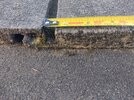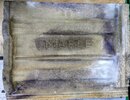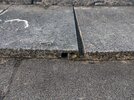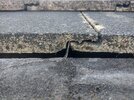You are using an out of date browser. It may not display this or other websites correctly.
You should upgrade or use an alternative browser.
You should upgrade or use an alternative browser.
Can DIYer Repair Roof?
- Thread starter Mr Sparkle
- Start date
Pray tell, what might it be? All the leaks, fixed or unfixed, I encountered are within that area.Bottom 20 % .. now I wonder why that would be ..
The tray needs to be rigid, else it will bow and create a back-fall for the felt/ membrane.I was going to use some dense polythene like DPC as opposed to an eaves tray. Are there any drawbacks to this? Is one more advantageous than the other?
DPC is a common cowboy traveller trick, and will hum like a vuvuzela when the wind gets to it.
- Joined
- 7 Sep 2022
- Messages
- 4,351
- Reaction score
- 1,244
- Country

Plan ahead. Scrwfix want 40 quid for 5 trays. e.g. These people: https://constructionmegastore.co.uk...trim-felt-support-tray?variant=47094943580471 want 25 quid for 2
Best value roofing felt at the moment seems to be cromar vent3, I get mine from eBay.. and bizarrely Jewsons knocked every other BM into a cocked hat last time I bought battens
Best value roofing felt at the moment seems to be cromar vent3, I get mine from eBay.. and bizarrely Jewsons knocked every other BM into a cocked hat last time I bought battens
Last edited:
- Joined
- 17 Dec 2018
- Messages
- 600
- Reaction score
- 15
- Country

Scaffolding delivered on Sunday, will get cracking this week.
Reading the above also helped remove the apprehension.
Yes, I will use some 2x1 battens. I will just place the new battens exactly where the old ones are. Thus keeping the spacing.
Will update thread as i get on.
That takes me back. I haven’t seen or heard these since the 2010 World Cup.
Regarding the breathable membrane
1. Are there any other breathable membranes/brands you would recommend?
2. The membranes come in various GSM’s e.g. 165, 135, 115, 95 etc. Should I just buy the thickest that I can afford?
3. I planned on using 1.5m widths membranes as opposed to 1m. The logic being, to avoid less laps/cuts etc. Is this a better idea?
Thank you so much for the advice. Particularly the part about not thinking "I'll just do a bit more".It doesn't really feel like working at height when there is a roof covering there and even when there is a felt, particularly when working from scaffold but you do have to have at the forefront of your mind all the time that there are only certain places where you can step on what you can see. Persevere, because the dislike of heights is a psychological thing that mostly only gets you when you're climbing the ladder or if you're looking over an edge. The rest of the job feels like kneeling on a slope; maintain caution and don't get complacent, and maybe don't do 8h plus days to start- it's very easy to think "I'll just do a bit more" and not recognise that you've gotten tired, cold, hungry etc - that's when mistakes are made. Start small and work up to it
Partial reroof makes sense and like I mentioned, it should be the case that not every course is nailed so a partial strip is easy enough. Remember basics like the felt higher up has to lap over the felt lower down - think like "if I was water, driven by gravity, where would I go?"
The batten spacing is determined for you; put the new in at the same as the old, and remember to match old and new sizes up. Post up on here for any advice as you go
Reading the above also helped remove the apprehension.
Yes, I will use some 2x1 battens. I will just place the new battens exactly where the old ones are. Thus keeping the spacing.
Will update thread as i get on.
Thank you. Rigid plastic eaves tray it is then.The tray needs to be rigid, else it will bow and create a back-fall for the felt/ membrane.
DPC is a common cowboy traveller trick, and will hum like a vuvuzela when the wind gets to it.
That takes me back. I haven’t seen or heard these since the 2010 World Cup.
That's brilliant. Great deal.Plan ahead. Scrwfix want 40 quid for 5 trays. e.g. These people: https://constructionmegastore.co.uk...trim-felt-support-tray?variant=47094943580471 want 25 quid for 2
Best value roofing felt at the moment seems to be cromar vent3, I get mine from eBay.. and bizarrely Jewsons knocked every other BM into a cocked hat last time I bought battens
Regarding the breathable membrane
1. Are there any other breathable membranes/brands you would recommend?
2. The membranes come in various GSM’s e.g. 165, 135, 115, 95 etc. Should I just buy the thickest that I can afford?
3. I planned on using 1.5m widths membranes as opposed to 1m. The logic being, to avoid less laps/cuts etc. Is this a better idea?
- Joined
- 17 Dec 2018
- Messages
- 600
- Reaction score
- 15
- Country

Which is generally better guys?
Buying/fitting the (I) eaves felt support tray and (II) Eaves Comb Filler separately
or buying a 3 in 1 part, like the link below, where they combine the eaves felt support, built in over fascia Vent and an eaves Comb Filler all together?
3 in 1 Eaves support tray and comb filler 1m lengths
Or does it not really matter?
Buying/fitting the (I) eaves felt support tray and (II) Eaves Comb Filler separately
or buying a 3 in 1 part, like the link below, where they combine the eaves felt support, built in over fascia Vent and an eaves Comb Filler all together?
3 in 1 Eaves support tray and comb filler 1m lengths
Or does it not really matter?
I hope that when you say you are hiring scaffolding you mean fixed scaffolding installed by professionals and not an aluminium tower?I also hate heights, so not sure how this is all going to work. But so excited.
I presume youve not worked on a scaffold before -if not, I suggest seeing if there is a video or something about best working practices -working off a scaffold is a bit weird it takes a while to get used to -for example have you considered where you will stack the tiles as you take the off -because scaffolding needed to have weight reasonably well distributed and you dont want tiles to be in the way of where you work
As you arent keen on heights, roofing might be a challenge -as you will be working mostly standing on the roof not the scaffold -have a think about that
- Joined
- 7 Sep 2022
- Messages
- 4,351
- Reaction score
- 1,244
- Country

Measure the battens on the roof if you haven't already; it's probably more common these days for battens to be 38x19mm (1.5x0.75) than 2x1 and you'll need to match what's thereYes, I will use some 2x1 battens
Note I typoed my original post and intended to note that the linked trays were 25 quid for 20, considerably cheaper than screwfixRigid plastic eaves tray it is then.
When roofing in cold weather be aware that plastics can snap easily when struck. Either warm them up using a hairdryer or heat gun before you pound a nail through them, or pre drill a hole and nail through them
Regarding the breathable membrane
For a basic job like this I'd go for the most cost effective at the thickness you feel is adequate. Remember it is not the job of the felt to carry water, so it's not necessary to install the thickest in expectation that it will last longerAre there any other breathable membranes/brands you would recommend?
A thicker membrane is likely to be slightly more forgiving if you put your foot in the wrong place - none of them are weight bearing but it should be harder to step a hole in a thicker one. If you do rip it, don't stress, just install another piece larger enough to completely cover the rip, reach the rafters neither side and extend up to the overlap to the next run above2. The membranes come in various GSM’s e.g. 165, 135, 115, 95 etc. Should I just buy the thickest that I can afford?
Doesn't matter about laps/cuts and 1.5m rolls can be heavy. If working with bigger rolls you might want to cut the length off and roll it up again before carrying it to fitting location so you aren't carrying the entire roll. Finding somewhere clean to roll it out with sharp bits of slate/tile and dropped nails poking through it is the challenge; unfurling it off the side of the scaffold on a calm day may be best. If you're unrolling it on the roof, tack a batten just above the working area, tack the felt to one end and unroll with the upper end of the roll on the batten, lower end in your hands, rolling along the batten. I find it easier doing this if working solo than unrolling on a lower battened section because the felt is more or less in place, wants to slide down under gravity which aids positioning and isn't in your way/on the things you will then step on. Only takes one nail to tack a batten and you'll be using that batten near by soon anyway so it's not a wasted trip carrying it up there3. I planned on using 1.5m widths membranes as opposed to 1m. The logic being, to avoid less laps/cuts etc. Is this a better idea?
Invest in some knee pads. Kneeling directly on battens and slates is not comfortable at all
Last edited:
- Joined
- 17 Dec 2018
- Messages
- 600
- Reaction score
- 15
- Country

The Marley interlocking roof tiles appear to have a worryingly large gap (10mm) in many places (pics attached). Should I be concerned about this?
Many of these gaps were filled with moss/ dust and soil. The neighbours (terraced houses) also have the occasional large gap
Removing the tiles, I noticed an interesting detail. The installer of the roof appears to have hammered a nail into the batten and then the metal piece, ties into the groove of the interlocking tiles (pics attached).
Was this normal back in the day? Is the purpose to keep the tiles locked in place?
Is it important to keep this detail?
So would it be okay to still use 38x19mm?
While measuring, I did notice that the batten was wet but structurally sound in terms of strength.
Brilliant tip. Will pre-drill and nail.
Working solo, so I will have to work smart.
Walking and hanging out on the roof was actually quite therapeutic I found.
Thank you for the tips in terms of setting out and things to consider on the job.
Many of these gaps were filled with moss/ dust and soil. The neighbours (terraced houses) also have the occasional large gap
Removing the tiles, I noticed an interesting detail. The installer of the roof appears to have hammered a nail into the batten and then the metal piece, ties into the groove of the interlocking tiles (pics attached).
Was this normal back in the day? Is the purpose to keep the tiles locked in place?
Is it important to keep this detail?
Measured the batten and I got 32x23mmMeasure the battens on the roof if you haven't already; it's probably more common these days for battens to be 38x19mm (1.5x0.75) than 2x1 and you'll need to match what's there
So would it be okay to still use 38x19mm?
While measuring, I did notice that the batten was wet but structurally sound in terms of strength.
When roofing in cold weather be aware that plastics can snap easily when struck. Either warm them up using a hairdryer or heat gun before you pound a nail through them, or pre drill a hole and nail through them
Brilliant tip. Will pre-drill and nail.
Went with Klober Permo Forte. It kept coming up when people would recommend membranes and I like the fact that it is known for its strength.For a basic job like this I'd go for the most cost effective at the thickness you feel is adequate. Remember it is not the job of the felt to carry water, so it's not necessary to install the thickest in expectation that it will last longer
A thicker membrane is likely to be slightly more forgiving if you put your foot in the wrong place - none of them are weight bearing but it should be harder to step a hole in a thicker one. If you do rip it, don't stress, just install another piece larger enough to completely cover the rip, reach the rafters neither side and extend up to the overlap to the next run above
Many thanks for this.Doesn't matter about laps/cuts and 1.5m rolls can be heavy. If working with bigger rolls you might want to cut the length off and roll it up again before carrying it to fitting location so you aren't carrying the entire roll. Finding somewhere clean to roll it out with sharp bits of slate/tile and dropped nails poking through it is the challenge; unfurling it off the side of the scaffold on a calm day may be best. If you're unrolling it on the roof, tack a batten just above the working area, tack the felt to one end and unroll with the upper end of the roll on the batten, lower end in your hands, rolling along the batten. I find it easier doing this if working solo than unrolling on a lower battened section because the felt is more or less in place, wants to slide down under gravity which aids positioning and isn't in your way/on the things you will then step on. Only takes one nail to tack a batten and you'll be using that batten near by soon anyway so it's not a wasted trip carrying it up there
Working solo, so I will have to work smart.
Safety first. So Scaffolding erected by professionals was put up.I hope that when you say you are hiring scaffolding you mean fixed scaffolding installed by professionals and not an aluminium tower?
I presume youve not worked on a scaffold before -if not, I suggest seeing if there is a video or something about best working practices -working off a scaffold is a bit weird it takes a while to get used to -for example have you considered where you will stack the tiles as you take the off -because scaffolding needed to have weight reasonably well distributed and you dont want tiles to be in the way of where you work
As you arent keen on heights, roofing might be a challenge -as you will be working mostly standing on the roof not the scaffold -have a think about that
Walking and hanging out on the roof was actually quite therapeutic I found.
Thank you for the tips in terms of setting out and things to consider on the job.
Attachments
Last edited:
- Joined
- 17 Dec 2018
- Messages
- 600
- Reaction score
- 15
- Country

.
- Joined
- 7 Sep 2022
- Messages
- 4,351
- Reaction score
- 1,244
- Country

See page 58 of the Marley installation guide I linked you toRemoving the tiles, I noticed an interesting detail. The installer of the roof appears to have hammered a nail into the batten and then the metal piece, ties into the groove of the interlocking tiles (pics attached).
Was this normal back in the day? Is the purpose to keep the tiles locked in place?
Is it important to keep this detail?
You're rebattening the entire roof(?) so.. yes..Measured the batten and I got 32x23mm
So would it be okay to still use 38x19mm?
Though if you're buying Kloeber PermoForte you're clearly not cheaping out so perhaps consider 38x25 battens rather than 38x19.
You aren't new building/I presume you have no BC oversight on this, so they don't have to be blue treated but if it were my roof I'd use treated batten
Not a sound assumption to make I'm afraid. A batten might look sound, and seem quite hard but compared to a brand new one, an old shagged one will bounce like a rubber band and/or split when you try to hammer nails into it; very hard to work with - don't reuse battensWhile measuring, I did notice that the batten was wet but structurally sound in terms of strength.
Perhaps one of the two tabs at the top of the tile, that keep it on the batten, has broke off and the tile has slip rotated. Or perhaps the batten isn't straight or rafters are not coplanar. When you install new battens and repair/replace the roof things will (can) look better/more uniformMarley interlocking roof tiles appear to have a worryingly large gap (10mm) in many places (pics attached). Should I be concerned about this?
Last edited:
- Joined
- 17 Dec 2018
- Messages
- 600
- Reaction score
- 15
- Country

Thank you.See page 58 of the Marley installation guide I linked you to
So according to the Marley guide, the ‘eaves clips’ are optional (i.e. installer can either nail tile, use eave clip or both). Also, if fitted, eaves clips should be installed on the eaves course tiles.
Given the above, it is baffling why the the existing roof tiles have eaves clips installed on rows of tiles above the eaves course?
Now I know the size of the existing roof batten, when I replace it could I use treated 2x1?You're rebattening the entire roof(?) so.. yes..
Though if you're buying Kloeber PermoForte you're clearly not cheaping out so perhaps consider 38x25 battens rather than 38x19.
You aren't new building/I presume you have no BC oversight on this, so they don't have to be blue treated but if it were my roof I'd use treated batten
I have plenty of this lying around from a previous project.
Yes, besides the roof tiles, all other materials will be brand new.Not a sound assumption to make I'm afraid. A batten might look sound, and seem quite hard but compared to a brand new one, an old shagged one will bounce like a rubber band and/or split when you try to hammer nails into it; very hard to work with - don't reuse battens
Given the pic/size of the gap between some of the tiles (ie. 10mm) could this be a cause of the water ingress?Perhaps one of the two tabs at the top of the tile, that keep it on the batten, has broke off and the tile has slip rotated. Or perhaps the batten isn't straight or rafters are not coplanar. When you install new battens and repair/replace the roof things will (can) look better/more uniform
Or would you expect water to still flow down the groove of the tile even if there is a gap?
DIYnot Local
Staff member
If you need to find a tradesperson to get your job done, please try our local search below, or if you are doing it yourself you can find suppliers local to you.
Select the supplier or trade you require, enter your location to begin your search.
Please select a service and enter a location to continue...
Are you a trade or supplier? You can create your listing free at DIYnot Local
Similar threads
- Replies
- 14
- Views
- 19K
- Replies
- 17
- Views
- 35K







